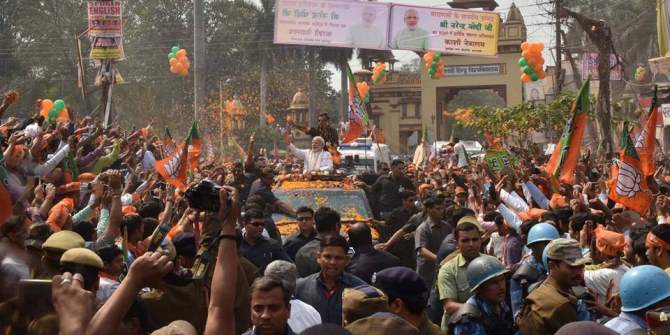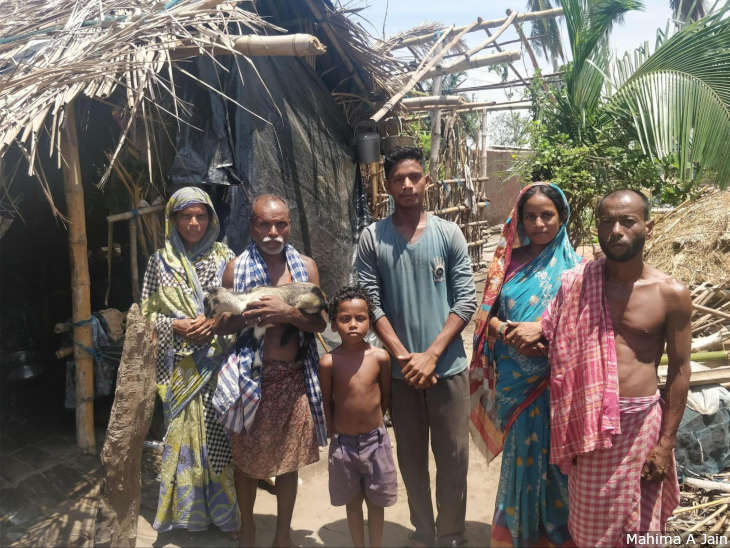 In 2011 Governor of Punjab was assassinated by Mumtaz Qadri for calling for the reform of Pakistan’s restrictive blasphemy law. On 29 February 2016, Qadri was executed for his crime. Usama Khilji writes that the execution shows the State’s firm rejection of violent extremism and mob justice. However, it also raises concerns about the barriers to reforming the blasphemy law and protecting the rights of minorities in Pakistan, and reopens the death penalty debate.
In 2011 Governor of Punjab was assassinated by Mumtaz Qadri for calling for the reform of Pakistan’s restrictive blasphemy law. On 29 February 2016, Qadri was executed for his crime. Usama Khilji writes that the execution shows the State’s firm rejection of violent extremism and mob justice. However, it also raises concerns about the barriers to reforming the blasphemy law and protecting the rights of minorities in Pakistan, and reopens the death penalty debate.
Mumtaz Qadri, the police bodyguard of former Governor of Punjab province Salmaan Taseer was executed on 29 February 2016 for killing him with 27 bullets on 4 January 2011. The assassination followed the Governor’s call to reform of Pakistan’s blasphemy law. The execution shows the State’s rejection of violent extremism and mob justice, but also raises concerns about the reform of the blasphemy law, rights of minorities, and the death penalty.
Governor Taseer, a member of the then-ruling Pakistan People’s Party (PPP), was one of the few politicians that had openly supported reform of the blasphemy law. In the lead up to his death he had requested a presidential pardon for Aasia Bibi, the first Christian woman in Pakistan on death row for blasphemy for allegedly insulting the Prophet on the farm she worked in Punjab. Taseer echoed what activists have been saying for years: that the blasphemy law is flawed and is abused to settle personal scores, mostly against members of religious minorities.
The blasphemy law
Pakistan inherited the blasphemy law from the Indian Penal Code promulgated by the British Raj in 1860 to deal with communal violence, mostly between Hindus and Muslims. Until changes to the blasphemy law were introduced by military dictator Zia-ul-Haq in 1980, there were only eight reported incidents of its use, none of which were against non-Muslims according to a report by the Islamabad-based Center for Research and Security Studies (CRSS). However, Zia’s amendments led to a spike in the number of cases of blasphemy between 1977 and 2012 to 328, as per the CRSS. He also introduced specific clauses targeting the Ahmedis, who were declared non-Muslims through the Second Constitutional Amendment, and the death penalty for insulting the Prophet under 295-C of the Pakistan Penal Code. There are currently 18 people on death row for blasphemy.
As the case of Taseer’s assassination demonstrates, extreme religious segments in Pakistan are not willing to even discuss reforming the law, and there is strong and often violent resistance to any such move. Clement Shahbaz Bhatti, Federal Minister for Minority Affairs and the only Christian and non-Muslim member in the PPP-led cabinet, also called for reforms of the blasphemy law and pardon for Aasia Bibi. He was killed by the Taliban on 2 March 2011, two months after Taseer’s assassination. In 2013, angry mobs set fire to dozens of houses in a Christian neighbourhood in Lahore over allegation of blasphemy by one of the Christian residents, who pleaded innocence and insisted the accusations were motivated by a property dispute. Simply an allegation of blasphemy is often enough to land someone in jail, with trials taking years.
The death penalty
Qadri’s execution was enabled by the fact that Pakistani Prime Minister Nawaz Sharif lifted the six-year moratorium on the death penalty as part of the 20-point National Action Plan (NAP) against terrorism chalked out after the 16 December 2014 terrorist attack on a school in Peshawar that left 162 dead (132 of which were children). However, local activists and international bodies such as the UN and Amnesty alike have called for reinstating the moratorium on the death penalty, arguing that executions do not curb violence.
Reaction to the execution
Many in Pakistan have hailed the decision of President of Pakistan not to accept Qadri’s plea for mercy as an important symbolic gesture showing that the State will not tolerate vigilantism. The Supreme Court decision rejecting Qadri’s appeal was also seen as historic as the judge clearly ruled that criticism of the blasphemy law is not tantamount to blasphemy. This was an important decision considering the amount of support Qadri had from religious groups that showered him with rose petals at his court appearances and exerted pressure on the judiciary.
The news of Qadri’s hanging resulted in riots in the urban centres of Pakistan, with protestors burning posters with images of Prime Minister Nawaz Sharif. Thousands gathered from all over the country at his funeral in Rawalpindi’s Liaquat Bagh, the same park where former Prime Minister Benazir Bhutto was assassinated in 2007. Some people wore ‘I am Qadri’ signs around their necks, and #IamMumtazQadri was one of the top trends on Twitter on the day of his funeral for the second time (the first being when Supreme Court upheld the Qadri’s death penalty). However, police booked 7,000 protestors and religious leaders for misusing loudspeakers and hurling threats to the State at protests in Karachi against the hanging of Mumtaz Qadri.
Terrorist organisations also reacted violently to the hanging, with a suicide bomber killing 17 people at lower courts in Shabqadar in the Khyber Pakhtunkhwa province on 7 March 2016. Jamat ul Ahrar, a splinter group of the Pakistani Taliban (TTP) claimed responsibility for the attack, and explicitly specified that they had targeted the judiciary for handing the death penalty to Mumtaz Qadri.
On 8 March 2016, Salmaan Taseer’s son Shahbaz Taseer, who was kidnapped shortly after his father’s assassination, was found near the city of Quetta in the Balochistan province by police. The timing of his release has raised questions, with some reports saying that he was unaccompanied when found because ransom was paid to the militant groups holding him, while the AFP quoted militant sources saying that Shahbaz could no longer be held due to a military operation around the tribal areas where he was being hidden.
Censorship
The Pakistan Electronic Media Regulation Authority (PEMRA) issued guidelines to the dozens of Pakistani TV news channels not to cover the execution of Mumtaz Qadri, threatening to cancel their licences if they disobeyed, a move which many say had the backing of the military. PEMRA is reported to have imposed fines on the two channels that defied the ban on coverage of the funeral. However, social media was buzzing with anger, some at the protests, but most at the execution. The assassination of Governor Taseer created an environment of fear, and most people who believe the law requires reform have since avoided speaking about it. Whereas the NAP includes curbing hate speech and glorification of terrorists on the media, social media platforms don’t afford such government control, though the government has in the past requested social media entities such as Facebook and Twitter to take down content that was considered blasphemous or critical of the state.
A turning point?
With the execution of Qadri, ban on coverage of the funeral, and booking of cases against pro-Qadri protestors, the State seems to be strengthening its writ that in the past has been challenged by militancy and mob violence in the name of religion. Considering the spill over effects into society over years, has the Pakistani state realised the danger of nurturing religious extremist groups (the same ones that it has used for strategic purposes since U.S.-backed support for Afghan Mujahedeen against the Soviet Union in the 1980s)? Will recent events lead to discussions about the possible amendment to the blasphemy law to prevent its abuse? How will the government deal with renewed opposition to reform from religious parties? How will it deal with Aasia Bibi’s case, whose death sentence is due to be appealed once again in March? Does this execution promise a safer Pakistan for religious minorities?
The Pakistani state must continue to lead the narrative against violent militancy without any exception, and maintain strong rule of law whereby mob justice, hate speech, and militant activity on any grounds is deemed completely unacceptable, in the true spirit of the National Action Plan. This project will also require broader long term changes, such as a revision of school textbooks that paint religious minorities unfavourably and teach a warped version of history, and regulation of religious seminaries that inculcate extreme religious ideologies promoted by Arab powers such as Kuwait, Qatar, Saudi Arabia, and the U.A.E.
Cover image credit: mlhradio CC BY-NC 2.0
Note: This article gives the views of the author, and not the position of the South Asia @ LSE blog, nor of the London School of Economics. Please read our comments policy before posting.
About the Author
 Usama Khilji is an activist and Chevening Scholar from Pakistan pursuing an MSc in Comparative Politics at the London School of Economics and Political Science. His interests include minority rights, online censorship, civic education, reform in Pakistan’s tribal areas, and peace in South Asia. He tweets @UsamaKhilji and blogs at usamakhilji.com.
Usama Khilji is an activist and Chevening Scholar from Pakistan pursuing an MSc in Comparative Politics at the London School of Economics and Political Science. His interests include minority rights, online censorship, civic education, reform in Pakistan’s tribal areas, and peace in South Asia. He tweets @UsamaKhilji and blogs at usamakhilji.com.







